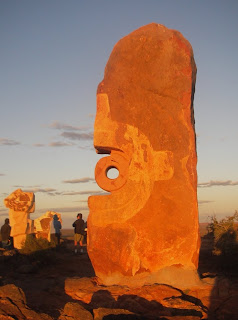Navigable aqueducts
played an important role in getting Great Britain’s industrial
revolution off the ground. In an age when railroads and commercial
highways had yet to be invented, these elevated artificial water bridges proved their worth at the time and have continued to do so for over two hundred years.

The Lune Aqueduct (above) supports the Lancaster Canal and towpath over the River Lune in
Lancaster, England. Designed by John Rennie following classical
architectural techniques, the 19 meters (62 ft) aqueduct over the River Lune is supported by 5 arched brick piers. It was built between 1794 and 1796, and its cost ran way over
budget preventing the Lancaster Canal from connecting to the main canal
network via the never-built aqueduct over the Ribble river. The Lune Aqueduct not only looks Roman, it was built using Roman
technology adapted by Rennie, to ensure the
stone bed of the aqueduct would not leak, Rennie specified the use of
Pozzolana powder, a Roman invention that allows concrete to set
underwater. The Lune Aqueduct is
still in use today.
 |
| Avon Aqueduct |
At 250 meters (810 ft) long and 26 meters (86 ft) high, the Avon
Aqueduct is Scotland’s longest and tallest aqueduct. Built after a
design by navigable aqueduct pioneer Thomas Telford, the Avon Aqueduct
features a cast iron trough supported by 12 brick and masonry arches.
The aqueduct runs through Muiravonside Country Park,
providing a spectacular scenic view from the park’s lush landscape or
from the top of the aqueduct itself.
The Avon Aqueduct carried the Union Canal and is located near Linlithgow
in West Lothian, Scotland. Three great navigable aqueducts facilitated
water traffic on the Union Canal, which opened in 1822 and was closed in 1965, with the Avon Aqueduct being the largest and longest of the three.
 |
| Pontcysyllte Aqueduct |
Engineer Thomas Telford designed the Pontcysyllte Aqueduct in Wales.It is the longest and highest
aqueduct in Britan at 1,007 ft (307 m) long, 11 ft (3.4 m) wide
and 5.25 ft (1.60 m) deep, it carries the Llangollen Canal over the River Dee in Wrexham, northeast Wales.
The Pontcysyllte (pronounced
“pont-ker-suth-tee”) Aqueduct may
have been the height -literally – of technology at the time, but its
construction involved some surprisingly unusual and ancient techniques.
One example is the mortar used to cement the masonry piers: it was made
from water, lime, and ox blood!
It is often the Pontcysyllte Aqueduct in TV programs and tourist publicity shots. It was added to theUNESCO World Heritage List
in 2009. The aqueduct is used regularly by pleasure boats and
commercial “narrowboats”, and once every 5 years it’s drained (by
removing a plug) for cleaning and routine maintenance.
More aqueducts at - you guessed it
WebUrbanist's "Slippery When Wet: The UK’s Top 10 Navigable Aqueducts"








































 The front cover features the Painted Desert Trading Post in Navajo, Arizona. It opened in the early 1940s selling Indian curios, but in the late 50s the highway was relocated and the building has sat empty and abandoned in the desert ever since. The Gascozark Cafe in Missouri was established in 1931 with the stone facade added in 1939. It operated as a popular tourist fishing resort for the Gasconade River. It is now vacant and abandoned.
The front cover features the Painted Desert Trading Post in Navajo, Arizona. It opened in the early 1940s selling Indian curios, but in the late 50s the highway was relocated and the building has sat empty and abandoned in the desert ever since. The Gascozark Cafe in Missouri was established in 1931 with the stone facade added in 1939. It operated as a popular tourist fishing resort for the Gasconade River. It is now vacant and abandoned.  Two Guns, between Flagstaff and Winslow Arizona (off topic -"standing on the corner in Winslow Arizona" is from Jackson Browne's 'Take it easy' sung by the Eagles). Apparently Two Guns was the site of a massacre of Apaches by the Navajo in 1881. The store, service station & motel are now a crumbling ghost town carrying the curse of bad luck for people entering or disturbing the Indian site.
Two Guns, between Flagstaff and Winslow Arizona (off topic -"standing on the corner in Winslow Arizona" is from Jackson Browne's 'Take it easy' sung by the Eagles). Apparently Two Guns was the site of a massacre of Apaches by the Navajo in 1881. The store, service station & motel are now a crumbling ghost town carrying the curse of bad luck for people entering or disturbing the Indian site. 




 Back in 1869 Russian chemist and inventor Dmitri Mendeleev presented his first Periodic Table of Elements. His table has been expanded over the past 142 years to accommodate new elements, and has been adapted to uses Dimitri could never imagined. The weird and wacky, like these Periodic Cupcakes -
Back in 1869 Russian chemist and inventor Dmitri Mendeleev presented his first Periodic Table of Elements. His table has been expanded over the past 142 years to accommodate new elements, and has been adapted to uses Dimitri could never imagined. The weird and wacky, like these Periodic Cupcakes -


 Collage in Jeannie Baker's "Window", superbly crafted into this bay window
Collage in Jeannie Baker's "Window", superbly crafted into this bay window

